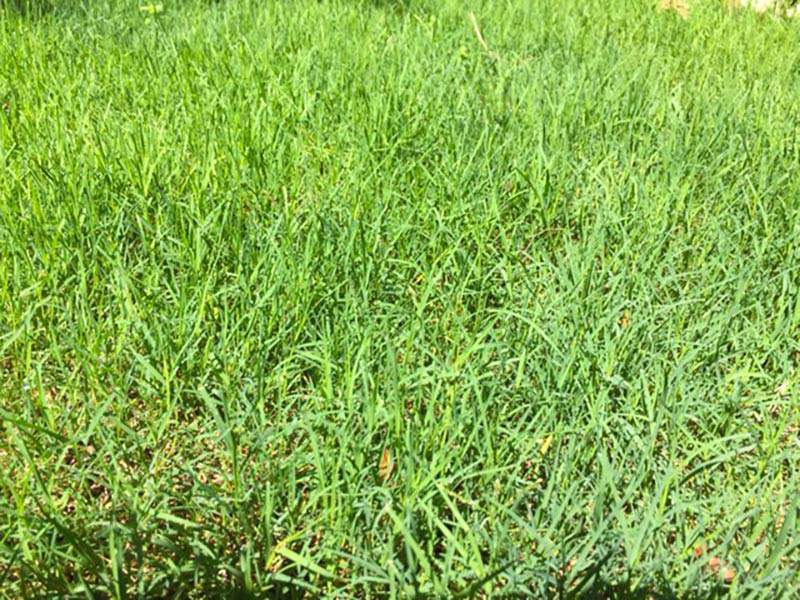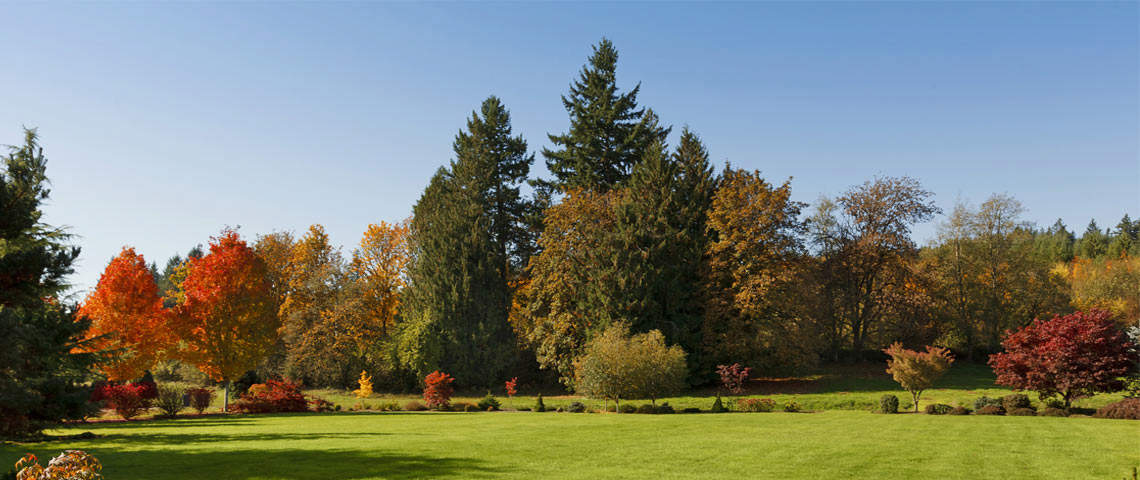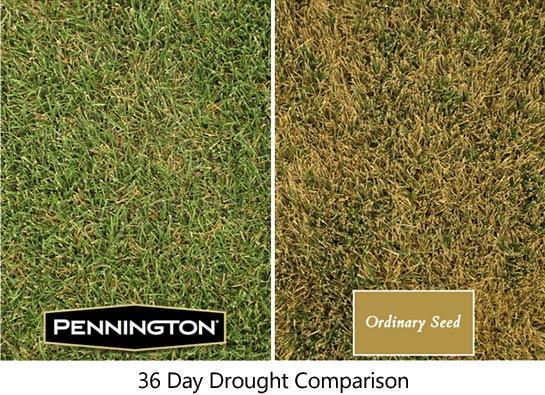Fall Color Retention in Bermudagrass

Bermudagrass (Cynodon spp) is one of the most important and widely adapted warm season turfgrass species. Advantages of bermudagrass are that it forms a fine dense sod, is very drought tolerant, and has relatively few insect and disease problems compared to other grass species. Limitations to bermudagrass and warm season grasses in general are that they go dormant and turn a tan straw color in areas that get below freezing temperatures, to some this is an unattractive feature.
Fall color retention is a term that should not be confused with cold tolerance. Cold tolerance refers to the ability of the turfgrass to survive through the winter months and is a concern with warm season turfgrasses in the transition zone. Cold tolerance is a measure of survival, and is a complex interaction of many factors: freezing temperatures, desiccation, pathogens, and abiotic factors. Extended growing season is a different concept which refers to how early the grass greens up, and how late into the fall the grass stays green. In this article we will discuss bermudagrass variety selection and aspects of turf maintenance in relation to fall color retention.
Location and Weather Patterns have an Impact
The climate and weather patterns of your location have a huge influence on fall color retention of bermudagrass, and what you are able to do as a turf manager to influence fall color retention of bermudagrass. A good general rule of thumb for bermudagrass growth is 55 F. Bermudagrass generally will not begin to green up in the spring with a soil temperature below 55 F (taken at a 4” depth), and in the fall bermudagrasses will start to loose their green color when the soil temperature drops below 55 F. When soil temperatures drop to and below 55 F, bermudagrass has difficulty producing chlorophyll more rapidly than it is degrading in the plant, particularly with high light intensity. As a result the turfgrass will start lose its dark green color. All bermudagrass will go dormant with air temperatures below 32 F. The ice crystals that form within the cells of the leaf tissue with freezing temperatures pierce the cell walls, ultimately killing the leaf tissue. It takes several days after this event for the bermudagrass to turn its characteristic dormant color; this is done gradually over the next several days as the sunlight degrades the chlorophyll in the leaf tissue.
In the southern bermudagrass belt (USDA Plant Hardiness Zones 8b-11) first frost is generally not encountered until mid-November or later. In these locations management practices can be performed to significantly increase fall color retention with little risk of winter injury to the bermudagrass. In the northern limit of bermudagrass use (USDA Plant Hardiness Zones 6 and 7) caution must be used with some management practices as they may lead to increased winter injury of the bermudagrass.
Cultivars Make a Difference
Santa Ana is a vegetative variety that was released specifically for its fall color retention (USDA, 1994). It was identified in southern California where the winters are mild, and soil temperatures generally don’t fall below 50 F. With proper management during years where these types of conditions prevail, it is possible to keep bermudagrass green year round. Windsor Green is a vegetative cultivar that is only commercially available in Australia that also possesses excellent fall color.
Table 1. Fall Color Ratings, Peninsula County Golf Club Inc., Frankston, Vic., Australia – 1996 & 1997
|
Variety Seeded |
1-9 (9=Complete color retention) |
|
|---|---|---|
|
Princess-77 |
4.5 |
|
|
Guymon |
2.1 |
|
|
Sultan |
1.8 |
|
|
Jackpot |
1.6 |
|
|
NuMex Sahara |
1.4 |
|
|
Mirage |
1.4 |
|
|
AZ Common |
1.2 |
|
|
Windsor Green |
6.6 |
|
|
Santa Ana |
6.0 |
|
|
Tifgreen |
5.2 |
|
|
LSD (0.05) |
0.9 |
|
Tifsport and Tifway (419) are two other vegetative varieties that have excellent fall color retention; and Princess-77 is a seeded bermudagrass that has excellent fall color retention (Table 2). Tifsport and Tifway are sterile interspecific hybrids that must be planted vegetatively, Princess-77 is a fertile intraspecific hybrid that can be seeded or vegetatively propagated. Some other cultivars provide moderate to good fall color retention and it is suggested that reference be made to the complete NTEP tables of the National Bermudagrass Test – 1997. These can be found either in printed reports or by visiting the NTEP web site –www.ntep.org.
Table 2. Fall Color (November) Ratings of Bermudagrass Cultivars – 2000 Data
|
Variety |
Tucson, AZ |
Riverside, CA |
Gainesville, FL |
Mean |
||||||||||
|---|---|---|---|---|---|---|---|---|---|---|---|---|---|---|
|
Seeded |
|
|
|
|
||||||||||
|
Princess-77 |
6.7 |
2.3 |
6.7 |
5.2 |
||||||||||
|
Savannah |
6.0 |
1.0 |
6.0 |
4.3 |
||||||||||
|
Sydney |
5.0 |
1.0 |
5.7 |
3.9 |
||||||||||
|
NuMex-Sahara |
5.0 |
1.0 |
5.3 |
3.8 |
||||||||||
|
AZ Common |
4.0 |
1.3 |
5.7 |
3.7 |
||||||||||
|
Mirage |
4.7 |
1.0 |
5.3 |
3.7 |
||||||||||
|
Jackpot |
4.0 |
1.0 |
5.3 |
3.4 |
||||||||||
|
Vegetative |
|
|
|
|
||||||||||
|
Tifsport |
6.7 |
3.0 |
7.3 |
5.7 |
||||||||||
|
Tifway |
6.0 |
3.0 |
7.3 |
5.4 |
||||||||||
|
Midlawn |
5.7 |
2.3 |
6.0 |
4.7 |
||||||||||
|
Tifgreen |
4.0 |
2.0 |
6.0 |
4.0 |
||||||||||
|
Cardinal |
3.7 |
2.3 |
3.0 |
3.0 |
||||||||||
|
LSD (0.05) |
2.0 |
0.9 |
0.9 |
0.8 |
||||||||||
This table contains all NTEP standard entries, top and bottom performing entries, and some select entries. However, only 12 of 28 entries are included – for full report see NTEP Progress Report 2000 – NTEP No. 01-5.
Management Practices can Promote Good Fall Color Retention
Fertilization and cultivation have been suggested as a means of extending fall color in bermudagrass, however few research results have been reported with fall color retention as the objective. Nitrogen and iron have often been shown to increase green color during the growing season if they are not readily available to the plant. In highly calcareous soils of the Southwestern United States and acid soils in the Southeastern U. S. available iron is often a limiting factor for optimum bermudagrass growth and color. Bermudagrass is widely known for its excellent response to nitrogen applications, resulting in rapid growth and a dark green color. Therefore, for good fall color retention nitrogen and iron should not be limiting.
Recent research at the University of California-Riverside has investigated management practices to increase fall color retention in bermudagrass. In the first two-year study nitrogen rates, foliar iron, and vertical mowing were examined for their influence on fall color retention. It was found that 1 lb/1,000 ft2 of nitrogen per month during late summer and fall promoted good color retention in late fall and early winter (Gibeault et al., 2002). Rates higher than 1 lb/1,000 ft2 of nitrogen should be avoided as excess nitrogen can result in too rapid an accumulation of thatch, and complicate other turf maintenance practices.
Nitrate sources of nitrogen should be used in fall and early winter for color retention, as nitrate nitrogen is readily available to the plant. Calcium nitrate and ammonium nitrate are good sources of readily available nitrogen, but must be watered in quickly as they have a high burn potential. Natural organic (sewage-based, and plant and animal based products, etc.) and synthetic organic (urea forms, IBDU, and methyleneureas, etc.) sources of nitrogen need to be converted to nitrate nitrogen before becoming readily available to the plant, and must under go biological or chemical conversions which are often temperature dependant. In cool soils these biological and chemical conversions take longer to occur, so the nitrogen is not as readily available to the plant.
In the second set of studies conducted at U.C. Riverside mechanical cultural practices were studied more intensely. Mowing height, scalping and vertical mowing were management practices that were examined (Figure 1). It was found that all could have a positive influence on fall color retention, but can have complex interactions with each other. Generally lower mowed turf, that has been verticut, or scalped can promote good fall color retention. By scalping or verticutting the amount of thatch present is reduced, which would allow for better light penetration through the canopy and soil heating, as well as promoting juvenile growth to come back from the crowns, stolons and rhizomes of the thinned turf promoting good fall color retention. This juvenile growth that results from the scalping and verticutting seems to hold its color better going into the fall.

Figure 1. Mr. Richard Autio and Dr. Vic Gibeault on fall color retention plots in Riverside, CA. The entire test area is Princess-77 bermudagrass fertilized at 1 lb/M during late summer and fall. The dormant plot is Princess-77 mowed at 5/8” with no scalping or verticutting during the growing season. The dark green plot in front of that was initially mowed at 5/8”, and on July 25 was scalped at 3/8”, and maintained at this height for the remainder of the season. This picture was taken on November 15, 2000.
If scalping or verticutting are performed they must be performed before late summer to allow the turf plenty of time to heal before growth slows with the cooler fall temperatures. If verticutting or scalping are done in the fall the turf will not have enough time to heal itself. Also, it has been observed in the transition zone that verticutting in the late summer can help reduce the injurious effects of spring dead spot the following spring as well.
Both selection of a cultivar, and the management of that cultivar can have an influence on fall color retention in bermudagrass. Management practices that can be used to extend fall color of a bermudagrass variety should be exercised with caution. For example, high nitrogen rates may extend fall color of bermudagrass in all locations, but in the transition zone this may result in severe winter kill, and lead to an increase in spring dead spot; whereas in the southern bermudagrass belt no adverse reactions would be observed with late nitrogen applications.
In most locations selection of a cultivar and management practices can increase fall color retention to an acceptable level for 2 – 6 weeks depending on weather patterns. Where winter soil temperatures don’t drop much below 55 F and freezing temperatures are not incurred it is possible to keep bermudagrass green year round.
Some turf managers and home owners perceive dormant warm season grasses as unsightly. In many regions of the country overseeding with annual or perennial ryegrass is performed to maintain year round green color. I too overseeded dormant bermudagrass my first years of living in the desert southwest. However, I soon realized that year round green was a lot of work and not very energy efficient. The tan color of the dormant bermudagrass is attractive, and no irrigation or management practices I can extend the growing season of my turf, as well as have a few months of rest and relaxation from yard work.
Increased fall color retention is just one of the many characteristics that plant breeders, and turfgrass managers are trying to improve through conventional means. Perhaps with new tools such as biotechnology fall color retention in warm season grasses may be improved dramatically. Stay tuned, there are many exciting improvements being made in bermudagrass.
References
Gibeault, V.A., R.E. Autio and S.T. Cockerham. 2002. Seeded Bermudagrass Fall Color Retention. California Turfgrass Culture. 52 (1-2): 1-5.
USDA. 1994. Grass Varieties in the United States. Soil conservation Service, Agriculture Handbook No. 170. pp. 50.
USDA and NTEP. 2000. National Bermudagrass Test – 1997. Progress Report 2000. NTEP No. 01-5.




